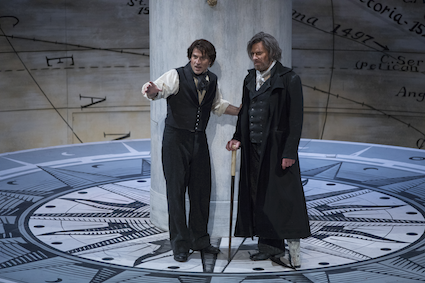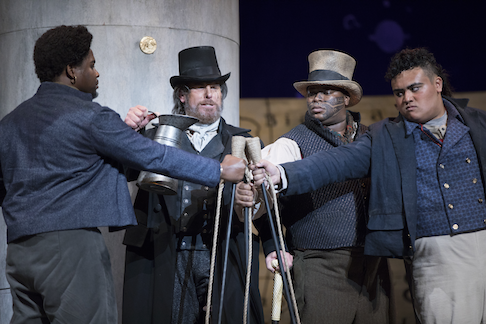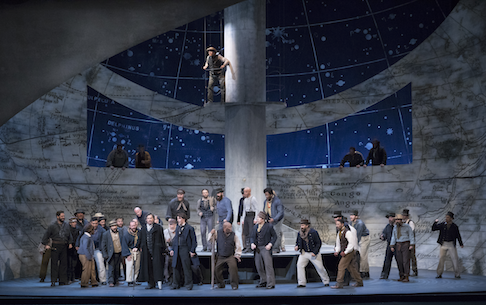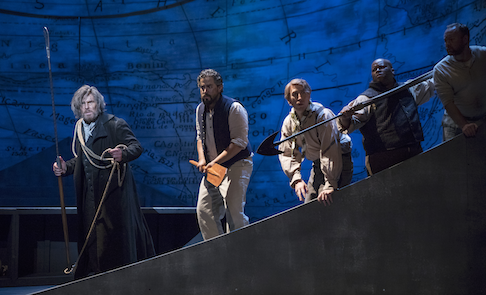
28 Jan 2018
Utah’s New Moby Dick Sets Sail
It is cause for celebration that Jake Heggie and Gene Scheer’s epic Moby Dick has been realized in a handsome new physical production by Utah Opera.
English Touring Opera are delighted to announce a season of lyric monodramas to tour nationally from October to December. The season features music for solo singer and piano by Argento, Britten, Tippett and Shostakovich with a bold and inventive approach to making opera during social distancing.
This tenth of ten Live from London concerts was in fact a recorded live performance from California. It was no less enjoyable for that, and it was also uplifting to learn that this wasn’t in fact the ‘last’ LfL event that we will be able to enjoy, courtesy of VOCES8 and their fellow vocal ensembles (more below …).
Ever since Wigmore Hall announced their superb series of autumn concerts, all streamed live and available free of charge, I’d been looking forward to this song recital by Ian Bostridge and Imogen Cooper.
Although Stile Antico’s programme article for their Live from London recital introduced their selection from the many treasures of the English Renaissance in the context of the theological debates and upheavals of the Tudor and Elizabethan years, their performance was more evocative of private chamber music than of public liturgy.
Evidently, face masks don’t stifle appreciative “Bravo!”s. And, reducing audience numbers doesn’t lower the volume of such acclamations. For, the audience at Wigmore Hall gave soprano Elizabeth Llewellyn and pianist Simon Lepper a greatly deserved warm reception and hearty response following this lunchtime recital of late-Romantic song.
For this week’s Live from London vocal recital we moved from the home of VOCES8, St Anne and St Agnes in the City of London, to Kings Place, where The Sixteen - who have been associate artists at the venue for some time - presented a programme of music and words bound together by the theme of ‘reflection’.
'Such is your divine Disposation that both you excellently understand, and royally entertaine the Exercise of Musicke.’
‘And there was war in heaven: Michael and his angels fought against the dragon; and the dragon fought and his angels, And prevailed not; neither was their place found any more in heaven … that old serpent … Satan, which deceiveth the whole world: he was cast out into the earth, and his angels were cast out with him.’
There was never any doubt that the fifth of the twelve Met Stars Live in Concert broadcasts was going to be a palpably intense and vivid event, as well as a musically stunning and theatrically enervating experience.
‘Love’ was the theme for this Live from London performance by Apollo5. Given the complexity and diversity of that human emotion, and Apollo5’s reputation for versatility and diverse repertoire, ranging from Renaissance choral music to jazz, from contemporary classical works to popular song, it was no surprise that their programme spanned 500 years and several musical styles.
The Academy of St Martin in the Fields have titled their autumn series of eight concerts - which are taking place at 5pm and 7.30pm on two Saturdays each month at their home venue in Trafalgar Square, and being filmed for streaming the following Thursday - ‘re:connect’.
The London Symphony Orchestra opened their Autumn 2020 season with a homage to Oliver Knussen, who died at the age of 66 in July 2018. The programme traced a national musical lineage through the twentieth century, from Britten to Knussen, on to Mark-Anthony Turnage, and entwining the LSO and Rattle too.
With the Live from London digital vocal festival entering the second half of the series, the festival’s host, VOCES8, returned to their home at St Annes and St Agnes in the City of London to present a sequence of ‘Choral Dances’ - vocal music inspired by dance, embracing diverse genres from the Renaissance madrigal to swing jazz.
Just a few unison string wriggles from the opening of Mozart’s overture to Le nozze di Figaro are enough to make any opera-lover perch on the edge of their seat, in excited anticipation of the drama in music to come, so there could be no other curtain-raiser for this Gala Concert at the Royal Opera House, the latest instalment from ‘their House’ to ‘our houses’.
"Before the ending of the day, creator of all things, we pray that, with your accustomed mercy, you may watch over us."
The doors at The Metropolitan Opera will not open to live audiences until 2021 at the earliest, and the likelihood of normal operatic life resuming in cities around the world looks but a distant dream at present. But, while we may not be invited from our homes into the opera house for some time yet, with its free daily screenings of past productions and its pay-per-view Met Stars Live in Concert series, the Met continues to bring opera into our homes.
Music-making at this year’s Grange Festival Opera may have fallen silent in June and July, but the country house and extensive grounds of The Grange provided an ideal setting for a weekend of twelve specially conceived ‘promenade’ performances encompassing music and dance.
There’s a “slide of harmony” and “all the bones leave your body at that moment and you collapse to the floor, it’s so extraordinary.”
“Music for a while, shall all your cares beguile.”
The hum of bees rising from myriad scented blooms; gentle strains of birdsong; the cheerful chatter of picnickers beside a still lake; decorous thwacks of leather on willow; song and music floating through the warm evening air.

It is cause for celebration that Jake Heggie and Gene Scheer’s epic Moby Dick has been realized in a handsome new physical production by Utah Opera.
The original premier’s set design by Robert Brill seemed to me not only definitive, but almost inextricable from the work’s success. Problem is that only the largest, most solvent companies could accommodate its demands.
The new, streamlined version on display in Salt Lake City not only keeps all of the fluid changes and atmospheric background for the monumental story, but actually also improves the stature of the work. With fewer eye-catching bells and whistles in the visuals, the ear is freed to pay closer attention to the bells and whistles in the score, and I was surprised how much richer I found Mr. Heggie’s accomplishment to be. More on the success of the design will follow.
I wholly admired the original conception, but on this occasion I came to believe this is the composer’s finest work to date. The score is wonderfully colored; the sea effects are sometimes lulling, sometimes wrenching; vocal writing is grateful and characterful; and the imposing, monumental, goose bump-inducing orchestral and choral writing that sweeps listeners along to the shattering climax are effectively balanced with moments of camaraderie and infectious humor.

Conductor Joseph Mechavich displayed equal flair for both the rhapsodic and intimate extremes in this varied score, and he shaped the evening’s musical arc with a firmly controlled reading. It helps that he has a seasoned ensemble of players under his baton, playing with a polish and unity of purpose that comes from having full-time employment as an orchestra. This fine band is one of the few in America that are employed 52 weeks a year and that approach pays big dividends in musical quality and cohesiveness.
Maestro Mechavich is aided mightily by Michaella Calzaretta’s superb choral preparation. Her large chorus was flawless in tonal beauty, dramatic engagement, and clarity of diction, even when performing busy stage movement. The musical excellence carried over to the principal singers who proved a top tier collective of singing actors.
Roger Honeywell doesn’t so much sing the role of Captain Ahab as inhabit it. Mr. Honeywell prides himself on being a committed actor first, and a suave vocalist second. In many of my memorable experiences viewing his performances, he has struck a bargain and offered tonal beauty and theatrical fire in equal measure. In this role assumption, Roger tilts the scale decidedly to the dramatic side, coloring his substantial, heroic tenor with ire, fanaticism and fateful determination.
While this makes for chilling dramatic effects, there are times that the voice turns hard, or even a mite unsteady. I have no doubt that this is his intent. His anguished, raspy moans as he dozes, are emitted with a huskiness of vocal production that would send most singers into apoplexy. But there is no question that Roger Honeywell, with his perfect diction and total emotional investment anchored (pun intended) the show.
As Starbuck, the strapping baritone David Adam Moore threatened to run off with the vocal honors. His beautiful, easily produced tone was even throughout the range, and his sensitive phrasing and dramatic understanding made a most appealing case for this sympathetic character. He found his equal in Joshua Dennis’ polished, mellifluously sung Greenhorn. Mr. Dennis’ well-schooled lyric tenor is not exceptionally large, but it is so well focused, and so limpidly produced that he made a resounding impression. He also embodied real pathos in his moving final scene.
Musa Ngqungwana brought a winning persona and orotund, rolling bass-baritone to the exotic character Queequeg. He not only impressed with his distinctive solo moments, but also made solid contributions in his touching duets with Mr. Dennis’ Greenhorn. Indeed the two created a magical, infectious relationship that was most appealing, and the major subplot in the story.

Joseph Gaines turned in his usual high quality performance as Flask, marked by a well-defined characterization, a good sense of fun, and a securely deployed tenor. His buddy, Stubb was enthusiastically impersonated by Craig Irvin, who showed off a shining, meaty baritone that was steady even as he was called upon to simultaneously do a sprightly jig. Indeed both Mssrs. Gaines and Irvin were delightfully fleet of foot in their animated performances.
The sole female voice, serving the role of the boy Pip, was the vibrant soprano Jasmine Habersham. The diminutive performer was suitably juvenile and her well-controlled, silvery tone had an alluring presence. Perhaps her voice is too “womanly” to utterly convince as the hapless lad, but this was an impressive role assumption, delivered with fierce commitment. Jesús Vicente Murillo did admirable double duty as Captain Gardiner and a Spanish Sailor; Babatunde Akinboboye made the most of his stage time as Daggoo; and the role of Tashtego was well-served by Keanu Aiono-Netzler. Anthony Buck was the firmly intoned Nantucket Sailor.
As impressive as all of these demonstrably fine singers were singly, they were most remarkable for their impressive ensemble work, thanks to inspired direction from Kristine McIntyre. Ms. McIntyre thrives on large cast extravaganzas, managing to move masses of singers meaningfully about the playing space, all the while effectively focusing attention on solo moments as required. She crafted richly detailed character relationships, and seemed to effortlessly manufacture one telling stage picture after another.
Having recently marveled at her Billy Budd at Des Moines Metro Opera, I am wondering if she is entering the nautical phase of her career? What’s next Kristine? Pinafore? Dutchman? I would sail well out of my way to see anything this talented director undertakes. She is especially adept at synchronized gestures, steps, and percussive effects, and there were many potent passages of unison group movement, with effective choreography incorporated by Daniel Charon.
Set designer Erhard Rom is celebrated not only for his artistic gifts but also for mounting attractive multiple sets with economy of means. His evocative, practical solutions here are praiseworthy indeed. Mr. Rom has borrowed a page from Wieland Wagner and placed a disc/platform center stage. Decorated with what suggests a compass, it spins to create multiple effects, with stairs, sleeping cubicles, and even a prow.
A large totem of a mast, with a perilous looking crow’s nest dominates the visuals dead center. The backdrop looks like someone took an old nautical map and subjected it to an imaginative paper cutting. The resulting silhouette with its swooping dip in the top center and large panoramic “window” suggests a colosseum. It turns out that opening can be closed by four separate panels, a device masterfully used in various combinations.
Mr. Rom meets the other requirements of varying locations by adding or subtracting furniture, angular insets flown in and out, and simple set pieces like the whaling boat. The grand drape not only sets the mood with its depiction of turbulent waves but is used for a startlingly good effect near opera’s end.

Lighting Designer Marcus Dilliard has provided one superb effect after another, from an azure starry sky to the fiery glow below deck to the mottled light of late afternoon to a gathering storm to a stylized whale hunt. Mr. Dilliard’s general washes always create just the right ambience, and his use of tightly focused areas and specials was highly proficient. Jessica Jahn’s spot-on costume design and Yancy J. Quick’s comprehensive wig and make-up design completed the look by so ably defining the characters and their stations.
The one important moment neither the original design nor this one fully mastered was the critical climactic moment of Ahab’s fateful confrontation with the whale. Rom, McIntyre, Dilliard and company have definitely come very very close. I will not spoil the surprise but I can say a truly menacing suggestion of the killer whale comes about in a surprising fashion. Ahab is suitably terrified, the music churns, the tension builds inexorably and then. . .the scenery takes an easy way out.
Still, this was such a stunning achievement full of so many memorable components, that it is easy to predict this winningly re-imagined Moby Dick will have a long and full run on national and world stages.
James Sohre
Cast and production information:
Captain Ahab: Roger Honeywell; Greenhorn: Joshua Dennis; Starbuck: David Adam Moore; Queequeg: Musa Ngqungwana; Flask: Joseph Gaines; Stubb: Craig Irvin; Pip: Jasmine Habersham; Captain Gardiner/Spanish Sailor: Jesús Vicente Murillo; Daggoo: Babatunde Akinboboye; Tashtego: Keanu Aiono-Netzler; Nantucket Sailor: Anthony Buck; Conductor: Joseph Mechavich; Director: Kristine McIntyre; Set Design: Erhard Rom; Costume Design: Jessica Jahn; Lighting Design: Marcus Dilliard; Choreographer: Daniel Charon; Wig and Make-up Design: Yancey J. Quick; Chorus Master: Michaella Calzaretta